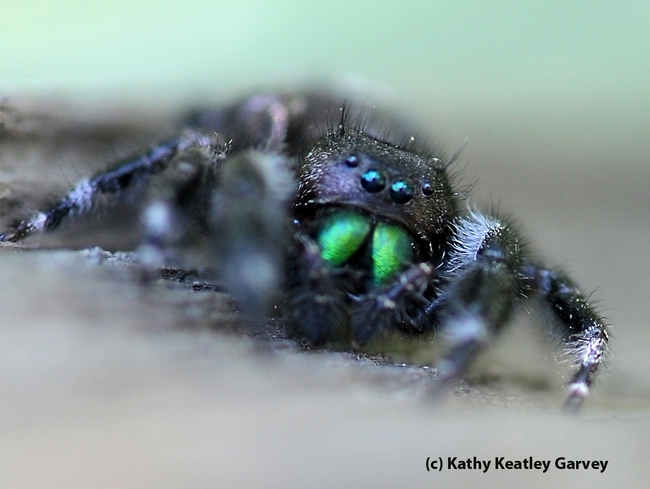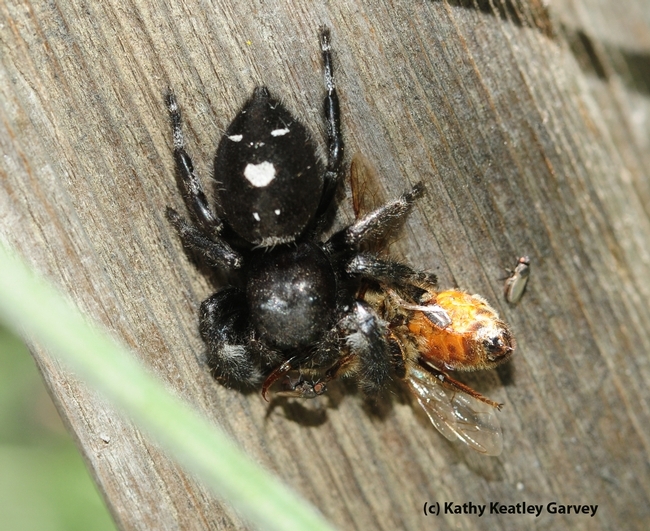If I had a pet jumping spider--which I don't--I'd name him "Jumping Jehosphaphat."
"The biblical king Jehoshaphat is the inspiration for the exclamation 'jumpin' Jehosaphat!' This alliterative idiom probably arose in the 19th century but was popularized by the cartoon character Yosemite Sam in the 20th century."--A Way With Words.
Don't know if any of the arachnologists attending the American Arachnological Society (AAS) meeting, June 26-30 at UC Davis, will say "Jumping Jehosphaphat." Probably not. (Maybe "If I say jump, you ask how high?")
However, when they kick off their conference with an open house, "Eight-Legged Encounters," at the Bohart Museum of Entomology from 1 to 4 p.m., Saturday, June 25, jumping spiders will be one of the species showcased. Some 20 tables of exhibits and activities will line the hall of the Academic Surge Building on Crocker Lane. It's free, open to the public, and family friendly.
The Bohart Museum, directed by UC Davis distinguished professor Lynn Kimsey, is the home of a worldwide collection of eight million insect specimens. It also houses a live "petting zoo" (Madagascar hissing cockroaches, stick insects and tarantulas) and an insect-themed gift shop.
A powerhouse of the nation's arachnologists will participate at the open house, according to arachnologist Jason Bond, associate dean, College of Agricultural and Environmental Sciences, and the Evert and Marion Schlinger Endowed Chair in Insect Systematics, UC Davis Department of Entomology and Nematology. He's chairing the conference with Lisa Chamberland, postdoctoral research associate, Department of Entomology and Nematology, and Joel Ledford, assistant professor of teaching, Department of Plant Biology, College of Biological Sciences.
Professor Eileen Hebets of the School of Biological Sciences, University of Nebraska, Lincoln, is co-hosting the Bohart open house as part of a U.S. National Science Foundation (NSF) grant, “Eight-Legged Encounters” that she developed as an outreach project to connect arachnologists with communities, especially youth. She seeks to educate the public “about the wonders of biology and the possibility of scientific discovery using a charismatic and engaging group of animals--arachnids. Arachnids (spiders and their relatives) are ubiquitous, thriving in most habitable environments on our planet (including underwater),” as mentioned on her website.
Jumping spiders, which belong to the family Salticidae, are "a large diverse group of spiders of about 4,000 species worldwide, and 300 in the United States," according to a Bohart Museum fact sheet that Kimsey authored. "These spiders are relatively small, usually less than 1 cm long. They are often brightly colored with reds, whites and even metallic green, particularly their chelicerae (jaws). They are extraordinary jumpers, and are known to be able to jump distances more than 10 to 40 times their body length."
Fact is, jumping spiders don't weave webs to catch their prey. They lie in wait and then pounce. "Jumping spiders are carnivores and can be effective garden pest control agents," Kimsey says. "They eat insects and other spiders about their size or smaller. They do not spin webs for catching prey, but may use a silken thread as an anchor as they climb down a vertical surface. These spiders are generally harmless to humans. They can bite, but this normally only happens when the spider is being crushed or other similar situation where its threatened with damage. The bites range from asymptomatic to small, mosquito-bite-sized welts. They are not as severe as a bee sting."
We've seen jumping spiders grab honey bees, syrphid flies, butterflies and other unsuspecting critters.
I never once thought of naming a jumping spider, but if I did, "Jumping Jehosphaphat!" would do.
At the open house, plans call for “A Name-that-Spider-Species" contest, coordinated by postdoctoral fellow Lisa Chamberland and doctoral students Iris Bright and Emma Jochim of the Bond lab. “We'll have an exhibit at the event with details on the spider (a male spider from the genus Promyrmekiaphila),” Bond said. “We'd like to restrict naming suggestions to be youths attending the event, students 18 years and younger."
"Lisa, Iris, and Emma have a poster put together on it," Bond said. The prize? The honor of naming the species and acknowledgment in a scientific paper.
Let's see...How about an individual name for the spider? Warrior, Speedster, Von Trapp, Fang, Charlotte, Spidey, or Itsy Bitsy?
Nah. How about Jumping Jehoshaphat?
Attached Images:

